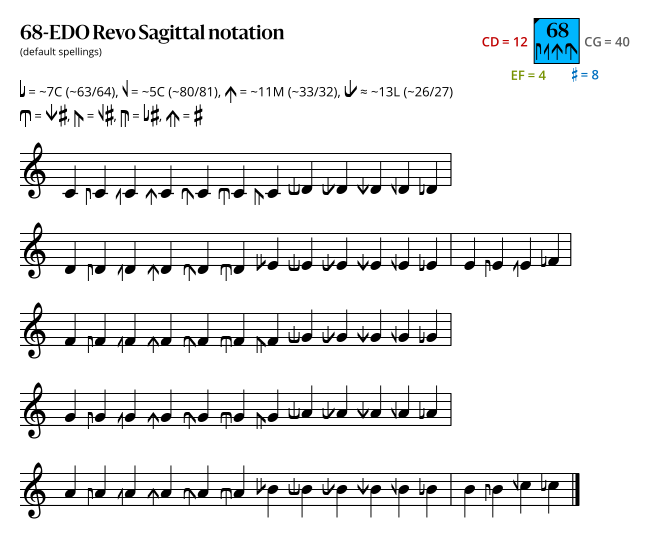68edo
| ← 67edo | 68edo | 69edo → |
68 equal divisions of the octave (abbreviated 68edo or 68ed2), also called 68-tone equal temperament (68tet) or 68 equal temperament (68et) when viewed under a regular temperament perspective, is the tuning system that divides the octave into 68 equal parts of about 17.6 ¢ each. Each step represents a frequency ratio of 21/68, or the 68th root of 2.
Theory
68edo's step is half of the step size of 34edo, which does well in the 5-limit but not so well in the 7-limit, and one quarter the size of 17edo, which does well in the 3-limit, but not so well in the 5-limit. The luck continues: 68 is a strong 7-limit system, but does not do as well in the 11-limit; though it's certainly usable for that purpose, it does not represent the 11-limit diamond consistently. However, 68edo maps many higher primes better than it does 11 (specifically 13 and 23 inherited from 17edo, 17 inherited from 34edo, and 19 and 31 new to 68edo), notably being consistent in the entire no-11s 25-odd limit add-31. It achieves this by having a consistent sharp tendency among all primes up to 31, save 11 and 29. Therefore, a slight octave compression, such as in 158ed5 or 191ed7, can improve upon the accuracy of 68edo's harmonic series.
As a 7-limit system, 68et tempers out 2048/2025, 245/243, 4000/3969, 15625/15552, 3136/3125, 6144/6125, and 2401/2400. It supports octacot, shrutar, hemiwürschmidt, hemikleismic, clyde and neptune temperaments, and supplies the optimal patent val for 11-limit hemikleismic.
The 3rd degree of 68edo can be used as a generator for stretched 23edo, which also acts as the quartkeenlig temperament tempering out the quartisma, 385/384 and 6250/6237. It results in a 23edo scale with octaves stretched by 1 step of 68edo (octaves of 1217.65 ¢). It also works as a 22L 1s MOS of the quartkeenlig temperament.
The 5th degree of 68edo can be used as a generator for 88cET, while two steps almost perfectly approximate 50/49, allowing for the tempering out of 2/(50/49)34.
Prime harmonics
| Harmonic | 2 | 3 | 5 | 7 | 11 | 13 | 17 | 19 | 23 | 29 | 31 | |
|---|---|---|---|---|---|---|---|---|---|---|---|---|
| Error | Absolute (¢) | +0.00 | +3.93 | +1.92 | +1.76 | -4.26 | +6.53 | +0.93 | +2.49 | +7.02 | -6.05 | +2.02 |
| Relative (%) | +0.0 | +22.3 | +10.9 | +10.0 | -24.1 | +37.0 | +5.3 | +14.1 | +39.8 | -34.3 | +11.5 | |
| Steps (reduced) |
68 (0) |
108 (40) |
158 (22) |
191 (55) |
235 (31) |
252 (48) |
278 (6) |
289 (17) |
308 (36) |
330 (58) |
337 (65) | |
Subsets and supersets
Since 68 factors into 22 × 17, 68edo has subset edos 2, 4, 17, and 34.
Intervals
| Degrees | Cents | Approximate ratios |
|---|---|---|
| 0 | 0.00 | 1/1 |
| 1 | 17.65 | 64/63, 126/125, 225/224 |
| 2 | 35.29 | 81/80, 49/48, 50/49 |
| 3 | 52.94 | 28/27, 36/35, 33/32 |
| 4 | 70.59 | 25/24, 22/21 |
| 5 | 88.24 | 21/20, 19/18, 20/19 |
| 6 | 105.88 | 16/15, 17/16, 18/17 |
| 7 | 123.53 | 15/14, 14/13 |
| 8 | 141.18 | 13/12 |
| 9 | 158.82 | 12/11, 11/10 |
| 10 | 176.47 | 10/9 |
| 11 | 194.12 | 28/25, 19/17 |
| 12 | 211.76 | 9/8 |
| 13 | 229.41 | 8/7 |
| 14 | 247.06 | 15/13 |
| 15 | 264.71 | 7/6 |
| 16 | 282.35 | 20/17 |
| 17 | 300.00 | 13/11, 19/16 |
| 18 | 317.65 | 6/5 |
| 19 | 335.29 | 11/9, 40/33, 17/14 |
| 20 | 352.94 | 16/13, 39/32 |
| 21 | 370.59 | 27/22, 26/21, 21/17 |
| 22 | 388.24 | 5/4 |
| 23 | 405.88 | 24/19, 19/15 |
| 24 | 423.53 | 14/11 |
| 25 | 441.18 | 9/7 |
| 26 | 458.82 | 13/10, 17/13 |
| 27 | 476.47 | 21/16 |
| 28 | 494.12 | 4/3 |
| 29 | 511.76 | 75/56 |
| 30 | 529.41 | 27/20, 19/14 |
| 31 | 547.06 | 11/8, 15/11 |
| 32 | 564.71 | 25/18, 18/13, 26/19 |
| 33 | 582.35 | 7/5 |
| 34 | 600.00 | 17/12, 24/17 |
| 35 | 617.65 | 10/7 |
| 36 | 635.29 | 36/25, 13/9, 19/13 |
| 37 | 652.94 | 16/11, 22/15 |
| 38 | 670.59 | 40/27, 28/19 |
| 39 | 688.24 | 112/75 |
| 40 | 705.88 | 3/2 |
| 41 | 723.53 | 32/21 |
| 42 | 741.18 | 16/13, 26/17 |
| 43 | 758.82 | 14/9 |
| 44 | 776.47 | 11/7 |
| 45 | 794.12 | 19/12, 30/19 |
| 46 | 811.76 | 8/5 |
| 47 | 829.41 | 44/27, 21/13, 34/21 |
| 48 | 847.06 | 13/8, 64/39 |
| 49 | 864.71 | 18/11, 33/20, 28/17 |
| 50 | 882.35 | 5/3 |
| 51 | 900.00 | 22/13, 32/19 |
| 52 | 917.65 | 17/10 |
| 53 | 935.29 | 12/7 |
| 54 | 952.94 | 26/15 |
| 55 | 970.59 | 7/4 |
| 56 | 988.24 | 16/9 |
| 57 | 1005.88 | 25/14, 34/19 |
| 58 | 1023.53 | 9/5 |
| 59 | 1041.18 | 11/6, 20/11 |
| 60 | 1058.82 | 24/13 |
| 61 | 1076.47 | 28/15, 13/7 |
| 62 | 1094.12 | 15/8, 32/17, 17/9 |
| 63 | 1111.76 | 40/21, 36/19, 19/10 |
| 64 | 1129.41 | 48/25, 21/11 |
| 65 | 1147.06 | 27/14, 35/18, 64/33 |
| 66 | 1164.71 | 160/81, 96/49, 49/25 |
| 67 | 1182.35 | 63/32, 125/64, 448/225 |
| 68 | 1200.00 | 2/1 |
Notation
Ups and downs notation
68edo can be notated using ups and downs notation using Helmholtz–Ellis accidentals:
| Step offset | 0 | 1 | 2 | 3 | 4 | 5 | 6 | 7 | 8 | 9 | 10 | 11 | 12 | 13 | 14 | 15 | 16 | 17 | 18 | 19 |
|---|---|---|---|---|---|---|---|---|---|---|---|---|---|---|---|---|---|---|---|---|
| Sharp symbol | |
|||||||||||||||||||
| Flat symbol |
Sagittal notation
This notation uses the same sagittal sequence as 75-EDO.
Evo flavor

Revo flavor

Evo-SZ flavor

In the diagrams above, a sagittal symbol followed by an equals sign (=) means that the following comma is the symbol's primary comma (the comma it exactly represents in JI), while an approximately equals sign (≈) means it is a secondary comma (a comma it approximately represents in JI). In both cases the symbol exactly represents the tempered version of the comma in this EDO.
Approximation to JI
Interval mappings
The following tables show how 15-odd-limit intervals are represented in 68edo. Prime harmonics are in bold; inconsistent intervals are in italics.
| Interval and complement | Error (abs, ¢) | Error (rel, %) |
|---|---|---|
| 1/1, 2/1 | 0.000 | 0.0 |
| 7/5, 10/7 | 0.159 | 0.9 |
| 15/13, 26/15 | 0.682 | 3.9 |
| 13/9, 18/13 | 1.324 | 7.5 |
| 7/4, 8/7 | 1.762 | 10.0 |
| 5/4, 8/5 | 1.922 | 10.9 |
| 5/3, 6/5 | 2.006 | 11.4 |
| 7/6, 12/7 | 2.165 | 12.3 |
| 13/12, 24/13 | 2.604 | 14.8 |
| 3/2, 4/3 | 3.927 | 22.3 |
| 15/14, 28/15 | 4.087 | 23.2 |
| 11/8, 16/11 | 4.259 | 24.1 |
| 13/10, 20/13 | 4.610 | 26.1 |
| 13/7, 14/13 | 4.769 | 27.0 |
| 11/9, 18/11 | 5.533 | 31.4 |
| 15/8, 16/15 | 5.849 | 33.1 |
| 9/5, 10/9 | 5.933 | 33.6 |
| 11/7, 14/11 | 6.021 | 34.1 |
| 9/7, 14/9 | 6.092 | 34.5 |
| 11/10, 20/11 | 6.181 | 35.0 |
| 13/8, 16/13 | 6.531 | 37.0 |
| 13/11, 22/13 | 6.857 | 38.9 |
| 15/11, 22/15 | 7.539 | 42.7 |
| 9/8, 16/9 | 7.855 | 44.5 |
| 11/6, 12/11 | 8.186 | 46.4 |
| Interval and complement | Error (abs, ¢) | Error (rel, %) |
|---|---|---|
| 1/1, 2/1 | 0.000 | 0.0 |
| 7/5, 10/7 | 0.159 | 0.9 |
| 15/13, 26/15 | 0.682 | 3.9 |
| 13/9, 18/13 | 1.324 | 7.5 |
| 7/4, 8/7 | 1.762 | 10.0 |
| 5/4, 8/5 | 1.922 | 10.9 |
| 5/3, 6/5 | 2.006 | 11.4 |
| 7/6, 12/7 | 2.165 | 12.3 |
| 13/12, 24/13 | 2.604 | 14.8 |
| 3/2, 4/3 | 3.927 | 22.3 |
| 15/14, 28/15 | 4.087 | 23.2 |
| 11/8, 16/11 | 4.259 | 24.1 |
| 13/10, 20/13 | 4.610 | 26.1 |
| 13/7, 14/13 | 4.769 | 27.0 |
| 15/8, 16/15 | 5.849 | 33.1 |
| 9/5, 10/9 | 5.933 | 33.6 |
| 11/7, 14/11 | 6.021 | 34.1 |
| 9/7, 14/9 | 6.092 | 34.5 |
| 11/10, 20/11 | 6.181 | 35.0 |
| 13/8, 16/13 | 6.531 | 37.0 |
| 9/8, 16/9 | 7.855 | 44.5 |
| 11/6, 12/11 | 8.186 | 46.4 |
| 15/11, 22/15 | 10.108 | 57.3 |
| 13/11, 22/13 | 10.790 | 61.1 |
| 11/9, 18/11 | 12.114 | 68.6 |
Zeta peak index
| Tuning | Strength | Octave (cents) | Integer limit | |||||||
|---|---|---|---|---|---|---|---|---|---|---|
| ZPI | Steps per 8ve |
Step size (cents) |
Height | Integral | Gap | Size | Stretch | Consistent | Distinct | |
| Tempered | Pure | |||||||||
| 354zpi | 68.049306 | 17.634273 | 7.666604 | 6.147517 | 1.254592 | 17.034505 | 1199.130531 | −0.869469 | 10 | 10 |
Regular temperament properties
| Subgroup | Comma list | Mapping | Optimal 8ve stretch (¢) |
Tuning error | |
|---|---|---|---|---|---|
| Absolute (¢) | Relative (%) | ||||
| 2.3.5.7 | 245/243, 2048/2025, 2401/2400 | [⟨68 108 158 191]] | −0.983 | 0.915 | 5.19 |
| 2.3.5.7.11 | 121/120, 176/175, 245/243, 1375/1372 | [⟨68 108 158 191 235]] | −0.541 | 1.206 | 6.84 |
| 2.3.5.7.11.13 | 121/120, 176/175, 196/195, 245/243, 275/273 | [⟨68 108 158 191 235 252]] | −0.745 | 1.191 | 6.75 |
| 2.3.5.7.11.13.17 | 121/120, 136/135, 154/153, 176/175, 196/195, 275/273 | [⟨68 108 158 191 235 252 278]] | −0.671 | 1.118 | 6.34 |
| 2.3.5.7.11.13.17.19 | 121/120, 136/135, 154/153, 190/189, 176/175, 196/195, 275/273 | [⟨68 108 158 191 235 252 278 289]] | −0.661 | 1.046 | 5.93 |
Scales
- See also: List of MOS scales in 68edo, 34edo #Scales, and 17edo #Scales.
- Negative semitone: 14 14 -1 14 14 14 -1 (E is sharper than F, and B is sharper than C)
- Deeptone[7]: 10 10 9 10 10 10 9
- Inverse half octave: 4 4 7 4 4 4 4 7 4 4 7 4 4 4 4 7
- Superpyth quarter octave: 3 3 1 3 3 3 1 3 3 1 3 3 3 1 3 3 1 3 3 3 1 3 3 1 3 3 3 1
- Quartkeenlig[23] (Stretched 23edo): 3 3 3 3 3 3 3 3 3 3 3 3 3 3 3 3 3 3 3 3 3 3 2
Instruments
Music
- Grown Apart from Self Similar (2023)





































